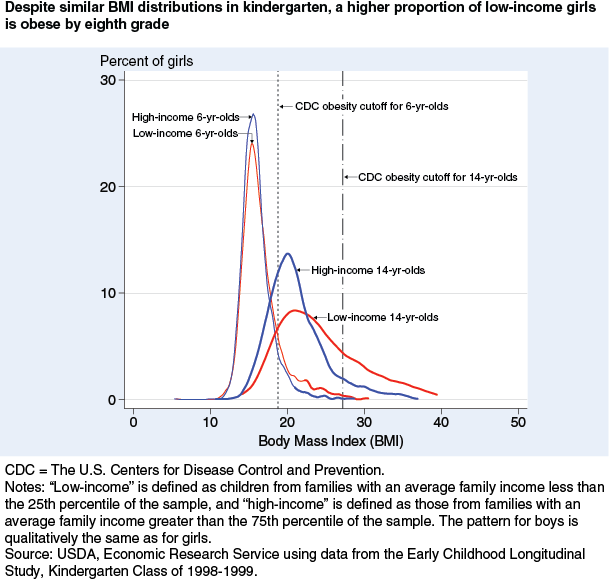Gap in Obesity Rates Between Low- and High-Income Children Widens With Age
- by Young Jo
- 12/7/2015
Statistics from the U.S. Centers for Disease Control and Prevention (CDC) indicate that about 17 percent of U.S. children and teens 2-19 years old were obese in 2011-12. Obese children are likely to become obese adults, putting them at risk of developing type-2 diabetes, osteoarthritis, and cardiovascular diseases.
A closer look at obesity statistics reveals that not all children are equally at risk. A higher proportion of children from low-income families are obese, compared with their peers from higher income families. (An obese child is one whose body mass index (BMI) is at or above the 95th percentile of the sex-specific CDC BMI-for-age growth chart.) ERS researchers investigated if the gap in obesity rates exists at birth or develops over time, and what factors may explain the gap. For their analysis, researchers used the U.S. Department of Education’s Early Childhood Longitudinal Study, Kindergarten Class of 1998-1999, which tracked a nationally representative sample of children attending kindergarten in 1998 until they reached eighth grade in 2006.
Low- and high-income children had roughly the same BMI distributions in kindergarten. However, by the time they reached eighth grade, a higher proportion of low-income children were obese, compared with high-income children. For instance, 20 percent of 14-year-old girls in the lowest family income quartile of the sample were obese, compared with 6 percent of those in the highest quartile. Boys displayed a similar pattern. The widening gap in obesity rates between low- and high-income children was especially pronounced among Whites, compared with other racial groups. Moreover, low-income children’s faster weight gain rather than their slower height growth is the main mechanism driving the widening of the gap.
The ERS researchers looked at factors that could potentially explain why low-income children gain weight faster as they age, compared with their higher income counterparts. Questions posed to 5th and 8th graders about their eating habits and physical activity levels revealed that a larger percentage of low-income children consumed sweets and fast food more frequently than high-income children in the sample, and a smaller percentage of them exercised frequently. However, the researchers could not pinpoint a single factor explaining why low-income children’s net caloric intake is higher than that of high-income children. Parental characteristics (employment status or behaviors), children’s participation in school meal programs, or other child-specific characteristics only accounted for a small portion of low-income children’s faster weight gain. The inability to identify one main factor behind the widening obesity gap could be attributed to data limitations or the complex nature of the underlying mechanisms.
This article is drawn from:
- Jo, Young. “What Money Can Buy: Family Income and Childhood Obesity.”. (2014). Economics & Human Biology 15: 1-12.
We’d welcome your feedback!
Would you be willing to answer a few quick questions about your experience?


